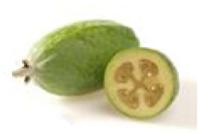
Feijoa – The Ornamental Shrub
Growing to maximum height of 4 metres, pineapple guava can be contained by pruning or growing in a tub. The glossy grey green leaves have a silver underside. Flowers are most attractive with white petals shading to purple, contrasting with the bright red stamens.
The Fruit
Green, oblong fruits have a rich fragrance when ripe. Thin inedible green skin surrounds creamy white flesh that is slightly grainy in texture. In the centre is a translucent jelly like pulp containing 30 – 40 very small seeds. Both the flesh and pulp are very well flavoured – like a blend of strawberry and pineapple – sweet and appealing. Feijoa juice is so strongly flavoured that it is best mixed with other juices. A very tasty and delicious jelly can be made from the pure juice. Also it can be made into an excellent wine – this is a joy I’ve yet to tryout for myself. Cut up fruits add an exotic taste to fruit salads. Talking fruit salads, the white thick petals of the Feijoa flower are sweet and good eating. They can be eaten with ice cream or added to fruit salads for a fascinating and different touch.
Harvesting
Like the Avocado, pineapple guava does not fully ripen on the bush. Choosing the time to pick the fruit therefore is not easy – particularly as it is green when underipe, and in full maturity. Some varieties show subtle colour changes as they approach maturity.
Fruits will fall to the ground when mature – this can lead to bruising and rapid rotting. When you suspect that maturity is near, gently handle the fruit. If ready it will come away in your hand. Fruit will need to be ripened at room temperature for 7 to 14 days. Ripening is speeded up by the presence of ethylene gas. Sealing fruit in a plastic bag together with an apple will accelerate ripening. Fruits that fall to the ground ripen quickly also and it is thought that the wound or bruising induces extra production within the fruit of this natural ripening gas. Cup the fruit in your hand and squeeze gently if it yields slightly then it’s ripe and ready for eating. Feijoa pulp freezes very well.
Varieties
The present Feijoa industry in New Zealand is based on seedling plants. Selection of superior varieties is proceeding at a rapid rate. Seedlings vary greatly in fruit quality and pollination requirements. Some seedlings are self fruitful – others need a second bush to pollinate their flowers. I recommend planting 2 or 3 seedling Feijoas to ensure cropping. The best named varieties are grafted to ensure the continuity of their desirable features. They are “Mammoth” – large oval fruits ripening mid-April and “Triumph” a heavy bearing bush with large smooth skinned fruits. Varieties “Large Oval” and “E4” show promise but are yet to be fully evaluated under our conditions.
While these grafted types are self fruitful it is still recommended that you plant 2 different varieties to increase yield and ensure full sized fruits. A~ with most fruiting plants, grafted or budded specimens are worth seeking out and paying extra for – they crop earlier – more reliably – and the fruit is considerably better eating.
Growing Conditions
Feijoa is probably the hardiest of the sub-tropical fruits. It’s drought resistant and will tolerate frosts down to minus 9 degrees centigrade. Best results will be achieved in areas within 30 – 40 kilometres of the coast from Geraldton to Esperance. Free draining soils, rich in organic material, full sun locations and wind protection are essential. While it can survive drought, Feijoa needs as much summer moisture as citrus for optimum cropping. Mulching is strongly recommended.
Pest Problems
The major pests of Feijoa in Western Australia are firstly fruit fly – secondly scale insects. Regular cover spraying with Hebaycid is the most effective control of the former. Malascale spray applied 2 or 3 times after an infestation is sighted will clear up scale insects.
Feijoa is particularly well suited to home garden growing with its exotic fruit, attractive appearance and its climatic tolerances. It , ease in growing make it an ideal starter crop for new fruit gardeners.
